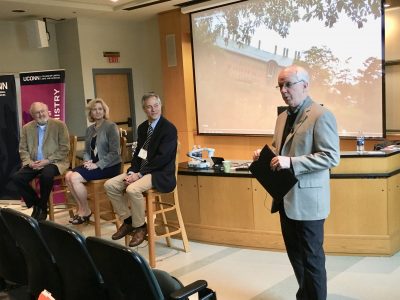
The headline from the recent “Building UConn Chemistry for Another 20 Years,” panel discussion wasn’t the whiz-bang technical stuff you might expect from an event like this, although that element was definitely present. What really jumped out were the timeless bits of advice from the panelists:
“Challenge the conventional wisdom.” – Gary Brudvig, Yale University
“We need to share more.” – Donna Huryn, University of Pittsburgh
“I’m big on dreams.” – Kenneth Raymond, University of California at Berkeley
The panel discussion was part of a day of events celebrating the 20th anniversary of the “new” Chemistry Building at the University of Connecticut. Emeritus Board of Trustees Distinguished Professor Harry Frank moderated the panel of Brudvig, Huryn, and Raymond. A milestone like the 20th anniversary provided the opportunity to assess where the field of chemistry is and where it should go, both in terms of new areas of investigation for research and the enterprise of academic research and training.
The usual subjects were discussed. Federal funding (NSF, NIH, DOE) is holding steady, but it’s not keeping up with the need. However, a growing role for foundations to support academic research—particularly translational research—was noted. The age-old question, “Whether applied or basic science?” also received attention. While there was strong support for basic investigations (“Charlie Townes couldn’t have envisioned the application of his laser technology for checking out your groceries,” Raymond mused.), the need for projects that directly impact society was clearly evident. “Big science versus individual investigator?” Both, depending on who you asked. No surprises here.
It was the emphasis on the how of scientific inquiry that outshone the what. Huryn led the charge on this topic with a challenge to rethink how researchers work together, on scales both large and small. Consider the lowly notebook: if divisions/departments switched to electronic notebooks, there would be continuity in the maintenance of data within a group. More importantly, that data could also be shared readily with external partners to help move the field forward. Huryn supported the idea that industry should share information on projects, such as the clinical data of failed compounds. Shared instrumentation, like HPLCs and LCMSs with supported technicians, was also offered as a way to move the field forward. Research infrastructure and dedicated technical specialists were uniformly cited as key components of successful research programs.
Raymond and Brudvig also offered insights on how young investigators should approach research. Raymond’s “I’m big on dreams” statement was less touchy-feely, and more a charge to aggressively take ownership of ideas and move them forward. Brudvig’s observations echoed that general sentiment: discoveries are made when practitioners take conceptual risks and question what is known.
Areas ripe for further investigation were also identified. A sampling included:
- Continuous processes. All agreed that the practical benefits of flow chemistry warrant increased research and broader implementation. “It’s time to leave the flask.”
- Energy, water, food. These are important globally. Brudvig remarked that if you solve energy, you’ve essentially solved water and food as a consequence.
- Dealing with data. Data handling was linked with Huryn’s initial commentary on sharing. We have data we don’t know what to do with. Cue AI and machine learning. And sharing.
- Emergent properties. Raymond’s preferred example was molecular weaving. He charted the progression of thread to cloth and its practical impact on humanity. “The same,” he said, “should be done on the molecular level (via supramolecular chemistry) to obtain materials with new properties.”
There is plenty of work to be done for those courageous enough to ask the questions and share what they’ve learned.